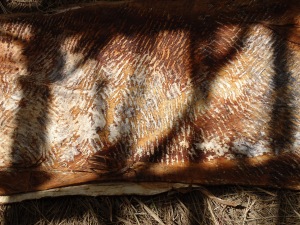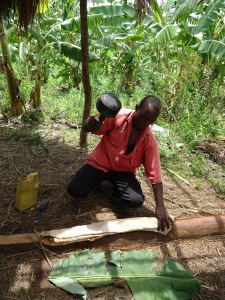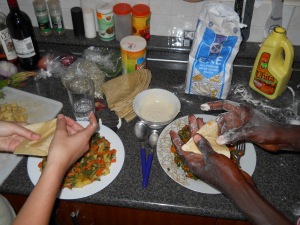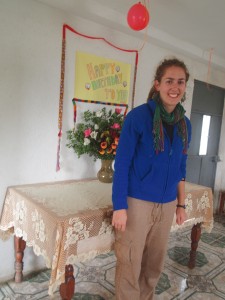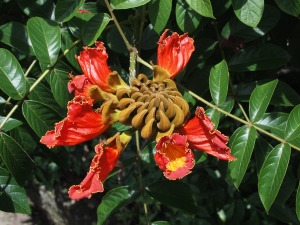Preface: peeps, these blog posts take me forever to write and upload pics for. Pay me back for my labors with a comment! I’ll appreciate it. More posts coming very soon.
3. Dig
I think I mentioned in a previous post that something like 85% of Ugandans make their living through small-scale agriculture– no tractors, no mechanization, just a lot of manual labor with hoes. In Uganda, this kind of work is called digging rather than farming or gardening. I don’t want to romanticize digging too much, but ever since I traveled through the beautiful lush Ugandan countryside I’ve had the urge to get my hands dirty and work in a garden. One morning, Grace told me she wasn’t going in to work. She didn’t want to get mixed up in the chaos surrounding the walk-to-work protests (google it… peaceful protests in Kampala against high fuel & basic commodity prices, which were put down by police with tear gas and rubber bullets)– and there was work to be done in the garden. “Can I help?” I asked.
I have to say, most Ugandans are really surprised that Americans are able to do any kind of useful labor. Washing dishes, doing laundry, using a hoe, making tea, handling tools of any kind… I have a hard time convincing people that I do all of these things by myself. “You Americans, your bodies are so soft and fragile!” our neighbor Resty told me once, after she expressed concern about me handling my teeny jewelry pliers. “You have no muscles!” I laughed and acted offended. Resty is always teasing, but she’s also serious. Anyway, when I volunteered to help in the garden, it caused some surprise and wonderment among Hanifa, Resty, and a couple other neighbors who stopped by.
Hanifa and I went first with hoes, making rows of holes in the rich already-tilled soil, and Grace followed, planting beans and corn. Grace and Resty:
These are happy feet.
The best part of digging was a feeling of belonging. In some ways, I think my Watson experience has been one big search for spaces and moments in which I feel part of a community. That morning of digging and laughing was one of those moments.
CHECK.
4. Finish my basket
For my last three weeks in Uganda, I spent my Wednesdays in Kinawa Kikajjo, a village on the outskirts of Kampala, at the home of Joyce, a master basket weaver who once spent a year demonstrating basket weaving in Busch Gardens in Florida, has done several Ten Thousand Villages artisan tours through the U.S., and regularly trains women in basket and dying technique. Basically, she’s a total pro at basketweaving and is the best possible teacher I could have. As always, I think what I enjoyed most is the conversations that happen as I sit side by side with another woman, learning her craft.
Joyce told me I was a good student! I was so proud!
CHECK.
5. Visit barkcloth makers in Masaka
When I visited the British Museum in November and saw their exhibit about modern African art, it was a barkcloth piece made by a Ugandan woman that caught my attention most. The barkcloth tradition is a unique aspect of Buganda material culture that’s recognized by UNESCO as an intangible element of world heritage. (Buganda is the tribal group that has historically ruled the central region of Uganda; the Baganda kingdom was a highly organized/developed political entity when the first Europeans came to Uganda.) Although bark has been made into cloth in other places, Uganda’s barkcloth is considered to be the finest in the world. In the past, before the advent of commercially produced cotton and silk fabrics, barkcloth was the material of choice for clothing and was also used to wrap bodies for burial (that practice continues today). The best barkcloth comes from Masaka, a town 2 1/2 hours south of Kampala. I visited Masaka and met up with Steven, a man who’s involved in various community projects in villages around Masaka town, and was the most enthusiastic host.
Ugandan barkcloth is made from the bark of the mutuba tree. On a mature tree, the bark can be harvested every six months to a year. The trees have to be pruned from a young age so that the lower part of the trunk is smooth, without any knots or branches, so that the finished barkcloth will be without blemishes.
Peeling back the bark:
During the dry season, the tree can dry out and die after its bark is removed, so the naked tree has to be covered with banana leaves or cow dung.
After the bark strip is removed, dry banana leaves are piled on the rough side and are burned. Then the rough outer bark is scraped off with a knife, leaving the pliable inner bark behind. Usually, pounding the bark with this huge ridged wooden mallet is a job strictly for men (gendered division of labor in crafts is so interesting!) but because I am a muzungu and a guest, I got to try my hand at it. It’s hard work! I did my best, though, partly motivated by a desire to promote girl power:
Mr. Elbino is a pro:
After the four rounds of pounding, the barkcloth has expanded to about four times its original size, and is left to dry in the sun (this sun exposure also gives it its brown color). Later, it will be sprinkled with water and pounded several more times with smaller, finer mallets.
Schoolchildren at Kasota Primary School are learning how to sew and embroider designs on barkcloth doll dresses. Here are some of the kids and the dresses they’ve made:
It was humbling and, I’ll admit, a little uncomfortable to be welcomed so warmly at the school– the kids sang for me! As a guest, I was given an enormous meal– about five plates of matoke, rice, spaghetti, meat and more… way more food than I can eat. I know that for many kids at that school, their only food for the whole day is the small cup of porridge that they’re given at lunchtime. I had so little to offer them– not money, not supplies, not expertise, not even a lasting presence. Humbling experiences seem to be a theme of this year, and learning to accept those situations with grace is a task that I’m still struggling with.
In Masaka town, I visited a shop owned by a woman named Margaret that sells entirely barkcloth products!! This is really unique; many Ugandans have a hard time accepting new/modern usages of barkcloth, because of ideas about modernization and a lingering association of barkcloth with death. Margaret sells items for tourists, but mostly she makes tailored gomesi (formal dresses) and other ceremonial wear. A photo of Buganda barkcloth regalia from one of her albums:
CHECK.
6. Cook a meal for my Ugandan family
I love cooking! And to counter the aforementioned misconception that Americans are incompetent (as well as express my gratitude for all the meals that Hanifa and Bene cooked for me) I really wanted to cook a meal for my Ugandan family, which is what Grace, Hanifa, Bene and Patricia became to me. I decided to make chicken fajitas– I make them often in the US, they’re an unusual food for Ugandans, and they’re easy to make with local ingredients. I told Grace about my plan and she was excited. Before I knew it, the meal that I had envisioned as a normal low-key evening had become an 11-person dinner party: Grace’s son Amos and three friends, our neighbor Resty and her maid Alice, plus the five of us.
The biggest adventure was making flour tortillas from scratch, which I’ve never done before . (Isn’t there some rule that you should never try a new recipe for company? Whoops.) Although it took longer than I expected to cook such a big batch of fajitas on the little charcoal stove, everything came together really well in the end! And I think my wonderful housemates were amused to see me at work in the kitchen.
Here’s the spread: flour tortillas, chicken fajitas with peppers and onions in a lime-garlic marinade, fresh salsa, guacamole, and shredded cheese. (Side note: we barely finished any of the cheese! Why don’t others appreciate cheese like Americans do?!)
CHECK.
———————
Too soon it was my last weekend. There were several nearly sleepless nights, owing to my desire to dance the night away and then wake up in the morning for Palm Sunday mass/market-wandering/final errands. And then there were a series of lasts: last mango purchased from the street vendors in downtown. Last ultimate frisbee practice under a bright pink sunset. Last post-practice meal of delicious roasted pork with my teammates. Last boda-boda ride. Last meal at Grace’s house, my final taste of matoke and g-nut sauce and dodo greens fresh from the garden. Last hugs and goodbyes.
Welaba, Uganda. I’m so grateful for my time there. I miss it already.








